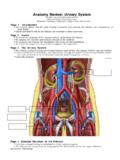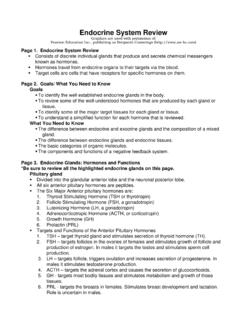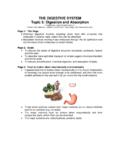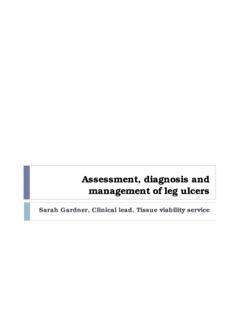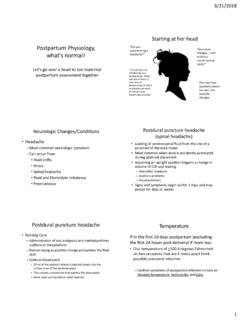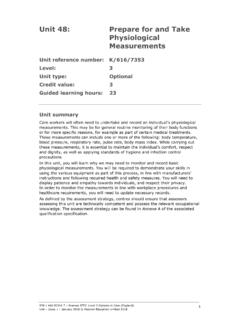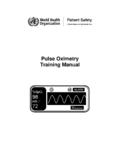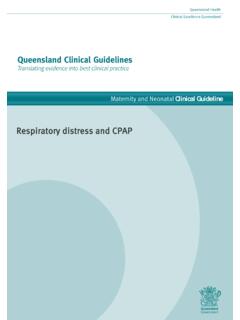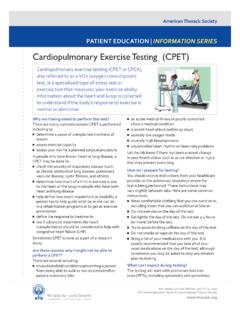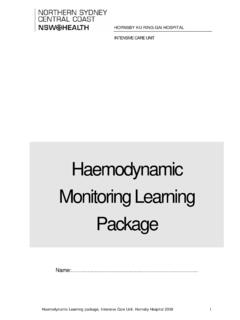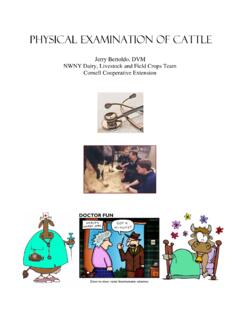Transcription of Factors that Affect Blood Pressure - Pearson
1 Interactive PhysiologyFactors that Affect Blood PressureGraphics are used with permission ( )Benjamin Cummings Publishing Co ( )Page 1. Introduction Blood Pressure is affected by several Factors : peripheral resistance vessel elasticity Blood volume cardiac output As you go through this topic, keep in mind this flow chart, which outlines the Factors affecting bloodpressure: Factors Affecting Blood PressureVessel ElasticityBlood Volume Cardiac OutputPeripheral ResistancePage 2. Goals To understand the Factors that Affect peripheral resistance, and therefore Blood Pressure . To understand how vessel elasticity, Blood volume, and cardiac output Affect Blood 3. Sources of Peripheral Resistance One of the main Factors that affects Blood Pressure is peripheral resistance. Blood cells and plasma encounter resistance when they contact Blood vessel walls. If resistance increases, then more Pressure is needed to keep Blood moving. Three main sources of peripheral resistance:1.
2 Blood vessel diameter2. Blood viscosity3. total vessel lengthFactors Affecting Blood PressureVessel ElasticityBlood Volume Cardiac OutputBlood Vessel Diameter Blood Viscosity Total Vessel LengthPeripheral ResistancePage 4. Vessel Diameter Analogy Vessel diameter affects peripheral resistance. As a the diameter of a tube gets smaller, a greater proportion of the fluid is in contact with the wall o fthe tube. Therefore resistance to flow is increased and Pressure rises. Larger diameter, same volume, less Pressure . Smaller diameter, same volume, more Affecting Blood PressureVessel ElasticityBlood Volume Cardiac OutputBlood Vessel Diameter Blood Viscosity Total Vessel LengthPeripheral ResistancePage 5. Vasomotor Fibers Constriction of Blood vessels raises Blood Pressure . Vessel diameter is actively regulated by vasomotor fibers, sympathetic nerve fibers that innervatethe vessel's smooth muscle Physiology2 Vasomotor fibers release norepinephrine, a powerful vasoconstrictor.
3 A vasoconstrictor is a substance that causes Blood vessels to 6. Vasoconstrictors Blood vessel diameter is also regulated by Blood -borne vasoconstrictors. Record the effect of each of these chemicals on the Blood vessel:EpinephrineAngiotensin IIVasopressinPage 7. Viscosity Demonstration Blood viscosity affects peripheral resistance. Viscosity is related to the thickness of a fluid. The greater the viscosity, the less easily molecules slide past one another and the more difficult it isto get the fluid moving and keep it moving. Because of this greater resistance to flow, a greater Pressure is required to pump the same volume o fviscous Affecting Blood PressureVessel ElasticityBlood Volume Cardiac OutputBlood Vessel Diameter Blood Viscosity Total Vessel LengthPeripheral ResistancePage 8. Blood Viscosity The hematocrit is the percentage of red Blood cells in the total Blood volume. The hematocrit affects Blood viscosity and therefore resistance to flow.
4 The more viscous the Blood , the greater resistance it encounters and the higher the Blood Pressure . The hematocrit can increase when there are more red Blood cells or less plasma in the Blood . The hematocrit can decrease when there are fewer red Blood cells or more 9. Vessel Length Total vessel length affects peripheral resistance. Increased fatty tissue requires more Blood vessels to service it and adds to the total vessel length i nthe body. The longer the total vessel length, the greater the resistance encountered, and the greater the Affecting Blood PressureVessel ElasticityBlood Volume Cardiac OutputBlood Vessel Diameter Blood Viscosity Total Vessel LengthPeripheral ResistancePage 10. Vessel Elasticity Besides peripheral resistance, Blood vessel elasticity also affects Blood Pressure . A healthy elastic artery expands, absorbing the shock of systolic Pressure . The elastic recoil of thevessel then maintains the continued flow of Blood during diastole.
5 When an individual has arteriosclerosis, arteries become calcified and rigid, so they can't expandwhen the pulse wave of systolic Pressure passes through them. Thus the walls of the arteryexperience higher pressures and become weaker and Physiology3 Factors Affecting Blood PressureVessel ElasticityBlood Volume Cardiac OutputBlood Vessel Diameter Blood Viscosity Total Vessel LengthPeripheral ResistancePage 11. Blood Volume Analogy: Hoses Blood volume affects Blood Pressure . When there is a greater volume of fluid, more fluid presses against the walls of the arteries resultingin a greater Pressure . When there is less volume there is less Affecting Blood PressureVessel ElasticityBlood Volume Cardiac OutputBlood Vessel Diameter Blood Viscosity Total Vessel LengthPeripheral ResistancePage 12. Blood Volume Examples Reduced Blood volume (for example due to excessive sweating) reduces Blood Pressure short term homeostatic mechanisms compensate, bringing Blood volume and Blood Pressure backup to normal levels.
6 Increased Blood volume (for example due to water retention from excessive salt intake) increasesblood Pressure short term. Long term homeostatic mechanisms compensate, bringing bloodvolume and Blood Pressure back up to normal 13. Cardiac Output: Heart Rate Anything that decreases cardiac output, also decreases Blood Pressure , because there is less pressureon the vessel walls. An increase in cardiac output results in increased Blood Pressure . Cardiac Output = Heart Rate X Stroke Volume Anything that affects heart rate or stroke volume affects cardiac output and thus Blood Pressure . What happens to heart rate, cardiac output, and Blood Pressure with parasympathetic stimulation(vagus nerve)?_____ What happens to heart rate, cardiac output, and Blood Pressure with sympathetic stimulation?_____Factors Affecting Blood PressureVessel ElasticityBlood Volume Cardiac OutputBlood Vessel Diameter Blood Viscosity Total Vessel LengthPeripheral ResistancePage 14.
7 Cardiac Output: Stroke Volume Affect of stroke volume on Blood Physiology4 If less Blood is ejected from the heart with each beat, then Blood Pressure will be lower because therewill be less Blood pressing against the vessel walls. Blood volume affects end diastolic volume and therefore stroke volume. With decreased stroke volume, due to decreased venous return, volume there is a decreased cardiacoutput and a decreased Blood Pressure . With increased stroke volume, due to increased venous return and/or increased contractility, there isan increased cardiac output and increased Blood 15. Summary Increases in peripheral resistance, Blood volume, and cardiac output result in higher Blood decreases in any of these Factors lead to lower Blood Pressure . Three main sources of peripheral resistance: Blood vessel diameter, Blood viscosity, and total vessellength. If arteries lose their elasticity and become more rigid, Blood Pressure increases.** Now is a good time to go to quiz question 1: Click the Quiz button on the left side of the screen.
8 Work through quiz question on Quiz Questions: Quiz Question #1: This question asks you to choose the Factors that will decrease the Blood Questions on Factors that Affect Blood Pressure :1. (Page 1.) What are the four main Factors affecting Blood Pressure ?2. (Page 3.) Blood cells and plasma encounter resistance when they contact Blood vessel walls. What is thisresistance called?3. (Page 3.) Is more or less Pressure needed to keep Blood moving when resistance increases?4. (Page 3.) What are the three main sources of peripheral resistance?5. (Page 4.) What is the relationship between the diameter of a tube and the proportion of fluid that is i ncontact with the wall of the tube?6. (Page 4.) What is the relationship between the diameter of a tube and resistance to flow? What effect doesthis have on Pressure ?7. (Page 5.) Does constriction of Blood vessels raise or lower Blood Pressure ?8. (Page 5.) What actively regulates the diameter of Blood vessels?
9 9. (Page 5.) What chemical is released by vasomotor fibers that acts as a powerful vasoconstrictor?10. (Page 6.) List three Blood -borne vasoconstrictors?11. (Page 7.) Explain (Page 7.) What is the relationship between viscosity and Pressure required to pump a fluid?13. (Page 8.) Define (Page 8.) What is the effect of hematocrit on Blood viscosity?15. (Page 8.) When does hematocrit increase?16. (Page 9.) What is the relationship between the total vessel length, resistance, and Blood Pressure ?17. (Page 10.) Why is expansion and recoil of the elastic arteries important?18. (Page 10.) Why does Blood Pressure often increase in individuals with arteriosclerosis?19 (Page 11.) What is the relationship between Blood volume and Blood Pressure ?20. (Page 13.) What is the relationship between Blood Pressure and cardiac output?21. (Page 13.) What is the relationship between heart rate, stroke volume and cardiac output?Interactive Physiology522. (Page 13.) What happens to heart rate, cardiac output, and Blood Pressure with both parasympatheticand sympathetic stimulation?
10 23. (Page 14.) What is the relationship between venous return and stroke volume?Answers to Questions on Factors that Affect Blood Pressure :1. peripheral resistance, vessel elasticity, Blood volume, cardiac output2. peripheral resistance3. more Pressure is needed4. 1. vessel diameter 2. Blood viscosity 3. total vessel length5. As the diameter of a tube gets smaller, a greater proportion of the fluid is in contact with the wall of As the diameter of a tube gets smaller, resistance to flow is increased and Pressure raises Blood pressure8. vasomotor fibers (also known as sympathetic nerve fibers)9. norepinephrine10. epinephrine, angiotensin II, vasopressin11. Viscosity is the resistance of a liquid to flow and is related to the thickness of a The greater the viscosity, the greater the amount of Pressure required to pump a the percentage of red Blood cells in the total Blood volume14. An increased hematocrit increases Blood viscosity and therefore increases resistance to flow.

